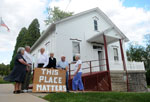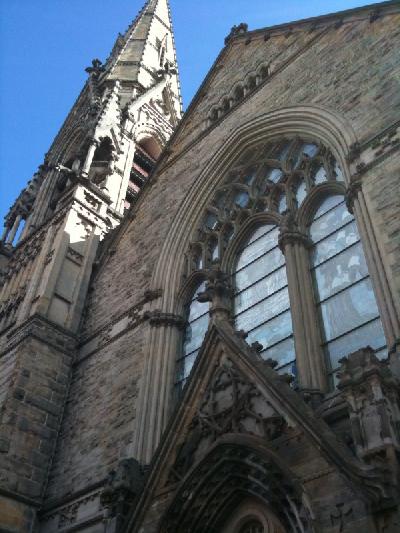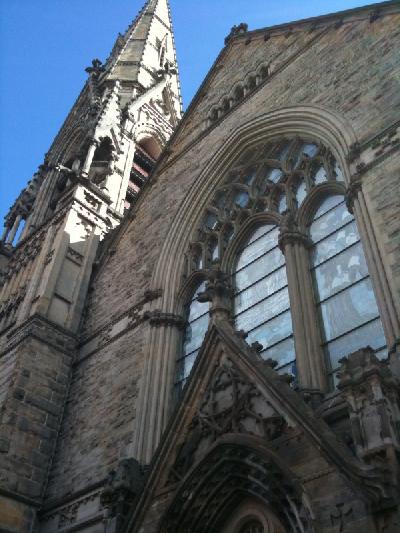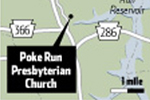
Category Archive: Historic Properties
-
On the Decision Regarding the Civic Arena by the Sports & Exhibition Authority
PHLF News
October 1, 2010We at Pittsburgh History & Landmarks Foundation regret the potential loss of the Civic Arena as a unique example of early modernism in American architecture.

Conceived by philanthropist Edgar J. Kaufmann, Sr. and funded as an innovative public-private partnership, the project was intended to be a grand contribution to the region––a “civic” auditorium and convention center. Mitchell & Ritchey, the premier Pittsburgh architectural firm during the city’s Renaissance, designed the Arena in 1954; it was completed in altered form in 1961. It was a daring, contemporary design and an extraordinary feat of engineering with the world’s largest retractable roof.
However, we also understand the practical difficulty of saving and finding a feasible use for it that will generate sufficient revenue to adapt and to maintain it. We also recognize that the local constituency in the Hill District and others who in the 1960s opposed the demolition of the Lower Hill for the development of the then-styled “Arts Acropolis” have negative feelings about the existence of the Arena, which caused the taking and demolition of many houses and businesses.
Early in the study period, we looked at the possibility of saving the steel structure that holds the leaves in place, together with retaining several of the leaves underneath, so as to project what the Arena originally was and to serve as a sculpture in the landscape. Unfortunately, because of the amount of land area that would be taken permanently for such a monument, the streets running from the Hill District to the City could not be reestablished with concomitant development. Considerable future maintenance costs would also be entailed.
We also recognize the financial problems of the City and the fact that it lacks revenue to sustain the infrastructure, buildings and green spaces that it already has, and that it cannot become the fiscal custodian of another major public place.
If time can be given to further study alternative uses for the Arena, as Senator James Ferlo has suggested, we would support that. However, there need to be feasible proposals that appear to warrant serious study.
From the outset of the discussions, we have advocated that Section 106 of the National Historic Preservation Act, and not just the State History Code, be followed by the Sports & Exhibition Authority (SEA). The Section 106 review process requires that alternatives be evaluated “that could avoid, minimize or mitigate adverse effects on historic properties,” and we understand that the SEA feels that the report by Michael Baker does that. The report, however, fulfills only part of the requirements and processes that are clearly defined in the Section 106 regulations.
We believe there is the possibility of jeopardizing the future use of federal funds for the redevelopment of the entire 28-acre Lower Hill site if Section 106 is not complied with prior to the demolition of the Arena. Section 110(K) of the National Historic Preservation Act prohibits “anticipatory demolitions” by placing a penalty on applicants of federal funds, including local governments, that intentionally destroy or harm historic properties prior to the completion of the Section 106 review process. The National Trust for Historic Preservation, our organization, and others have informed the SEA that proceeding with the demolition of the Arena may jeopardize the future use of federal funds at the site and make the federal funds vulnerable to legal challenge.
The Hill District is now engaged in a master planning process. The Penguins have provided a plan to establish a street grid reuniting the Lower Hill with downtown, including a connection over the Crosstown Expressway, and to create opportunities for major development. The land will be returned to the tax roles and enormous development opportunities, particularly for housing, will present themselves.
The Arena issue is a difficult one for all of us in the preservation community. Those who opposed the original urban renewal plan to demolish the Lower Hill and erect the Arena find themselves with the choice of trying to save the Arena or endorsing a plan that calls for the establishment of an urban street grid along with new development that supports the Hill District community’s desire to develop a plan that reunites the Hill District with the City.
This is not the first time that our community has had to deal with such an issue, nor will it be the last. Urban renewal of the 1960s deprived us of significant buildings, familiar street grids, and landscapes to be replaced by structures that at the time were generally not felt by preservationists to be equal in design quality to what was being lost. We hope that further discussion regarding the Arena and each related project will be conducted with objectivity and civility.
In the case of the Arena, we would favor its preservation if a practical plan were to be put forth that did not add to the financial burden of the City, that generated tax revenues from the land in the Lower Hill and development opportunities as well, and was supported by the Hill District residents.
If the Arena is to be removed, we then support the plan to establish an urban street grid, opening the land to provide development opportunities to a variety of developers, and we will suggest that a high standard of contemporary design be required.
-
Allegheny County to Hold Meeting for Public Input on South Park Fairgrounds Planning
PHLF News
September 22, 2010Allegheny County will hold a public meeting on Wednesday, September 29, from 7:00 to 8:30 p.m. at the South Park Fairgrounds Museum Building to ask for input on the future planning of the South Park Fairgrounds and the surrounding areas.“Allegheny County has undergone a remarkable economic and environmental transformation, and the time has come to also transform the South Park Fairgrounds into a modern facility that reflects the needs of today’s park users,” said Onorato. “We are asking residents to help us create a sustainable development plan that makes the most of this significant public asset.”Building upon the Master Planning process previously conducted for the parks, Allegheny County is working with GAI Consultants to create a plan that incorporates today’s best green and sustainable development approaches.The public meeting will introduce the project and the public process, and provide opportunities for participants to share their experiences and ideas. The effort is part of Onorato’s County Parks Action Plan, which is transforming and enhancing recreational opportunities at the County’s nine regional parks.For those who are unable to attend the public meeting, a survey is available online at www.alleghenycounty.us/parks/SPFairgrounds. -
Farmers Pursue New Purposes to Preserve Age-Old Livelihood
Thursday, September 16, 2010By Karen Kane, Pittsburgh Post-GazetteThere’s a saying in farm circles: Get big or get out. But some farmers here are proving there’s another way to survive. Diversification — essentially a “re-purposing” of the family farm — is bolstering profits and enhancing staying power at a time when many farmers feel forced to trade their tractors for briefcases or hard hats.
The strategies are varied: the berry farmer who begins baking and selling berry pies; the crop farmer who opens his land for hunting; the tree farmer who transforms a barn into a gift shop.
Each strategy has two things in common: eliminating the middleman — which strengthens the connection between the farmer and the public — and putting more money in the pockets of the farmers’ overalls.
It’s win, win, win — for the farmers looking to preserve their way of life; for a region in which agriculture is a key economic generator; and for suburbanites and others who yearn for locally produced foods.
Rooted in ideasThe future of family farming will be rooted as much in creative thinking as in the dirt, said Leah Smith of the Pennsylvania Association for Sustainable Agriculture. The group’s mission is to promote profitable farms that produce healthy food and respect the environment.
“We are challenging the conventional idea that you either get big or get out in agriculture. We are finding new ways to connect with consumers and give them an opportunity to get closer to the family farm,” Ms. Smith said.
For John Kennedy of Middlesex, the son of a dairy farmer, it “hit him hard” as a teenager that “there are only so many ways to support yourself on the farm, and I’d better start trying some more.”
He was in high school when the drought of 1988 struck, sending shock waves through the farming community. “I realized that I didn’t want to be totally at nature’s mercy for my livelihood, but I wanted to continue to farm,” he said.
He sold the Camaro he had bought with his 4-H project earnings over the years and used the money to buy game birds. He and his wife, Valarie, now operate the 450-acre Four Seasons Game Bird Farm, a regulated hunting preserve in Middlesex.
The couple still raise crops and animals on the land, but when the growing season is just about finished, the property is opened for guided hunting expeditions for ring-necked pheasant, quail and chukar partridges.
“To … pay the bills and have any type of extra, you can’t just do one type of farming any more,” Mrs. Kennedy said. She said that she and her husband knew before they began raising their three children — ages 4, 8 and 11 — that farming was the lifestyle they wanted. And they knew they needed to diversify to make it work.
That’s the message that Jane Eckert conveys when she speaks at conventions across the U.S. The owner of Eckert AgriMarketing in St. Louis, Ms. Eckert is a consultant who has made it her mission to help the family farm survive.
“It’s about supplementing a farmer’s income,” said Ms. Eckert, who comes from a long line of farmers. “The family farm today has a very hard time making it economically. But people in this business are in it because they love farming.”
She said her focus is helping a farmer recognize a strategy for diversification.
“We look at the land, the assets and we say, ‘Gee, how about adding a snowmobiling trail for winter?’ Or, we explore the value of selling their products on the farm or starting a B&B or opening up for pick-your-own,” she said.
So’Journey Farm, Greene CountySandra Brown, owner of So’Journey Farm in Jackson, did just that.
A rug-weaver who conducts workshops on the craft, she moved from Pittsburgh to the 45-acre farm five years ago at age 58 with a desire for farm living and a determination to make it income-producing.
She zeroed in immediately on livestock — she says she has a “real passion for growing really good food” — and figured that using her 1880s farmhouse as a B&B would add a level of financial certainty to the operation.
“I knew going in that agritourism was the way to go,” she said.
She now raises laying hens, French roasting chickens and Scottish Highland beef cattle. She “harvests” her own animals and makes the most of her assets, moving her chickens around to feed so their manure will fertilize different areas of the farm and turning over her orchard to her cattle for grazing. She barters with local farmers for use of heavy equipment that she doesn’t want to buy and makes direct sales to consumers, charging premium prices — $4.50 a pound for the roasters, for example — for her grass-fed beef and her free-ranging chickens.
Asked about profitability, she answers: “It’s more than paying for itself.”
Sand Hill Berries, Westmoreland CountyAt Sand Hill Berries in Mount Pleasant Township, one might say the story began humbly — with pie.
Susan Lynn, who bought the 110 acres in 1981 with her husband, Richard Lynn, said what has become a major farm, food and tourist operation happened “almost by pure accident.”
Initially, the couple began planting trees: sugar maple, apples, pears, peaches and sour cherries. But they noticed that raspberries were growing wild throughout the property. Thanks to pure serendipity, they came upon someone desperate to move 7,000 raspberry bushes and they got them cheap. When the bushes began bearing fruit, the Lynns did what most growers do: They sold the berries wholesale — until one year when unseasonably hot weather produced poor-quality California berries that drove down berry prices.
“That made us see that we needed other venues for the product,” she said.
The next thing she knew, she was marketing berry pies and dessert toppings directly to festivals.
Then came a Victorian-era raspberry-infused vinegar. Then jams and jellies for gift baskets. Then a little on-site retail store to sell the products. Then a dessert cafe on the farm for those who were visiting and wanted just a piece of pie. In 2007, they added a winery and a Nectar Garden.
Soon, people were asking to be married on the property and to hold receptions there.
“We’ve got people waiting for dates in 2012,” Mrs. Lynn said of the operation that now involves other members of the family as well as a couple of outside partners.
Mrs. Lynn said the enterprise has been and continues to be an adventure that isn’t making them rich but is keeping the family in business.
“We grow what we sell. We’re proud of that. There’s no middleman,” she said.
Her advice to others: “If you grow raspberries, you better make jelly.”
Hozak Farms, Beaver CountyMarty Hozak of Hozak Farms in Hanover agrees that diversification transformed their family farm from a “standard pigs-chickens-and-egg operation” that barely supported his grandfather to an enterprise that supports himself; his son; his parents, Bob and Virginia; and his sister, Ellen Dillon.
The change began when his father read an article while in college that said raising Christmas trees could be a money-making venture. The first planting was in 1949.
For several years, Bob Hozak wholesaled the cut trees and, as the son puts it, “It was easier money than chickens.” But soon the realization dawned that direct sales was more profitable.
“We started having people who wanted to cut their own tree. And that’s when things began rolling,” Marty Hozak said.
The occasional cut-your-own request became an all-out effort to “create an experience, make a memory” for the visitor, with tractors that hauled customers out to the woods and a gift shop in a renovated barn where tree lights and ornaments were displayed.
For a number of years, the Hozaks were all about Christmas. Then, in the 1980s, they decided to expand their season to include fall. A pumpkin patch was grown and the tractors that were used to transport tree-cutters were used for fall hayrides.
The next step is figuring out what to do in spring or summer.
“If you want to make a go of it in family farming nowadays, you don’t just grow one crop or do one thing,” Marty Hozak said. “You get creative. You diversify.”
-
Blaze Destroys Landmark Building in Edgeworth
Thursday, September 16, 2010By Moriah Balingit, Pittsburgh Post-GazetteIt took just a handful of minutes for a fast-moving blaze to destroy nearly a century and a half of history as it tore through a Edgeworth home Wednesday afternoon
Owners Roger Wiegand and his wife Kay and three or four others were at the house, located at 420 Oliver Road, when smoke detectors went off, alerting local firefighters at 4:18 p.m. Everyone made it out safely, but by the time firefighters and police arrived on scene, the fire had already spread to all floors.
“When I went in … it was full of smoke,” said Patrolman Paul Yonlisky, of the Edgeworth Police Department, who said he was the first on scene. He quickly turned back.
By the time Chief Tim Scott, of the Edgeworth Volunteer Fire Department, arrived on scene, about four minutes after the initial call, he could see fire and smoke on both floors, and flames were licking the eaves of the home.
“It was already into the attic space,” he said.
It took more than three hours and 40 to 50 firefighters from six area companies to extinguish the fire. Chief Scott expected to have firefighters there late into the night to ensure that there were no hot spots.
The fast-moving blaze was likely stoked by the house’s old wooden frame, he said.
The facade of the home that faced Oliver Road, a stately colonial brick structure painted white, remained mostly intact Wednesday evening, as firefighters continued to search for hot spots in the five-bedroom, 7,600 square foot home. But the home’s steep slate roof had caved in and remained intact in only one corner of the house, said Chief Scott. The interior of the home had been gutted in parts, and a stairwell had collapsed.
Still, firefighters who filed in and out of the home carted out artwork, some fronted by shattered glass, delivering it to family members standing nearby. A large flat-screen television also survived the fire.
And Chief Scott said he believes the home can be rebuilt.
Paula Doebler, a close friend of Mrs. Wiegand’s who lives in nearby Sewickley, rushed to the scene when she heard on the news that the house was on fire. She said that Mrs. Wiegand is an interior decorator, and the house, which features a roof porch supported by iconic columns, was among her crown jewels.
Mrs. Wiegand had just remodeled the kitchen and the home’s style was “slowly but surely changing over to contemporary.”
“The home was just beautiful,” she said.
Chief Scott said Mrs. Wiegand was “very upset.”
The family declined comment at the scene.
Built in the mid-1800’s, the mansion was once home to the Edgeworth Female Seminary, a school for girls. It was named for Irish novelist Mary Edgeworth and drew students from New England and the South.
Later, the home become the property of the Edgeworth Social Club. When the borough was founded in 1904, it took the name Edgeworth, according to the borough’s website.
-
Between a Ramp and a Hard Place
Friday, September 10, 2010 11:33 AMWritten by Diana Nelson Jones
To some people, the historic standards that prohibit vinyl windows and metal awnings are dictatorial. To others, those standards safeguard authenticity and dumbing down is not an option.
When it’s your own budget, a little gray can seep into the argument.
Even someone who appreciates the high standards that are supposed to be followed in an historic district can sympathize with a building owner who needs to replace five 10-foot-tall windows in a group of Victorian row houses. Ouch.
But when you buy in an historic district you’re investing in more than a building.
The people of Calvary United Methodist Church in Allegheny West have been diligent in following the historic course. Their partner, the Allegheny Historic Preservation Society, helped them raise the more than $2 million needed for interior and exterior repairs in the late 1990s. That included removing some of the world’s largest Tiffany windows for cleaning and releading.
Visit their web site at www.calvarypgh.com.
They have raised about $180,000 for the next “must-do” project — making their fellowship hall in the basement accessible to the increasing numbers of people who use the church. They are anticipating six bids for a job that calls for an elevator, a new door carved into the side off the parking lot and a 30-foot ramp with an historically acceptable railing and ramp foundation. Which means limestone.
Based on the first bids to come in, Rev. Larry Homitsky tells me, the church is short somewhere between $75,000 and $120,000. The Historic Review Commission offered some flexibility on the railing but insisted on the limestone. Rev. Homitsky and the church’s architect will reappear before the HRC next month, maybe with hat in hand.
He said the church has had “tremendous support” over the years in grants and other gifts. Many people see Calvary as more than a church, in part because it is on the National Register of Historic Places and also because thousands of people a week, mostly from the community but not necessarily in the congregation, use it to practice yoga, square dance, learn art and confirm the day-at-a-time struggle against addiction. The Allegheny West Civic Council meets there the second Tuesday of every month. A lot of brides who want a beautiful church for their wedding pick Calvary instead of the one they go to. More than 1,000 Christmas house tourists converge on the church as a point of interest.
The time, effort and money spent in being an historic property is important, said Rev. Homitsky. That, set alongside the “ministry value” of functioning for people is the challenge.
If you want to help Calvary make their basement accessible and do it at historic standards, they will take donations. Specify on your check that it is meant for the ramp and elevator project and mail it to the church at 971 Beech Ave., Pittsburgh 15233.
-
Between a Ramp and a Hard Place
Friday, September 10, 2010 11:33 AMWritten by Diana Nelson Jones
To some people, the historic standards that prohibit vinyl windows and metal awnings are dictatorial. To others, those standards safeguard authenticity and dumbing down is not an option.
When it’s your own budget, a little gray can seep into the argument.
Even someone who appreciates the high standards that are supposed to be followed in an historic district can sympathize with a building owner who needs to replace five 10-foot-tall windows in a group of Victorian row houses. Ouch.
But when you buy in an historic district you’re investing in more than a building.
The people of Calvary United Methodist Church in Allegheny West have been diligent in following the historic course. Their partner, the Allegheny Historic Preservation Society, helped them raise the more than $2 million needed for interior and exterior repairs in the late 1990s. That included removing some of the world’s largest Tiffany windows for cleaning and releading.
Visit their web site at www.calvarypgh.com.
They have raised about $180,000 for the next “must-do” project — making their fellowship hall in the basement accessible to the increasing numbers of people who use the church. They are anticipating six bids for a job that calls for an elevator, a new door carved into the side off the parking lot and a 30-foot ramp with an historically acceptable railing and ramp foundation. Which means limestone.
Based on the first bids to come in, Rev. Larry Homitsky tells me, the church is short somewhere between $75,000 and $120,000. The Historic Review Commission offered some flexibility on the railing but insisted on the limestone. Rev. Homitsky and the church’s architect will reappear before the HRC next month, maybe with hat in hand.
He said the church has had “tremendous support” over the years in grants and other gifts. Many people see Calvary as more than a church, in part because it is on the National Register of Historic Places and also because thousands of people a week, mostly from the community but not necessarily in the congregation, use it to practice yoga, square dance, learn art and confirm the day-at-a-time struggle against addiction. The Allegheny West Civic Council meets there the second Tuesday of every month. A lot of brides who want a beautiful church for their wedding pick Calvary instead of the one they go to. More than 1,000 Christmas house tourists converge on the church as a point of interest.
The time, effort and money spent in being an historic property is important, said Rev. Homitsky. That, set alongside the “ministry value” of functioning for people is the challenge.
If you want to help Calvary make their basement accessible and do it at historic standards, they will take donations. Specify on your check that it is meant for the ramp and elevator project and mail it to the church at 971 Beech Ave., Pittsburgh 15233.
-
Poke Run Presbyterian Church Divided Over Historic Building
By Chuck Biedka, VALLEY NEWS DISPATCH
Friday, September 10, 2010
Last updated: 7:11 am
From left, Emma and Jim Dunmire, of Washington Township; Jack and Eleanor Zerbini, of Salem Township; Maynard Miller, of Kiski Township; and Kathy Moneymaker, of Washington Township, all gather together in front of the Academy Building located beside the Poke Run Church located in Washington Township on Thursday. Erica Hilliard/Valley News Dispatch
Nine members of Poke Run Presbyterian Church are asking Westmoreland County Court to side with history and preserve the church’s academy building and its contents.
The four couples and one individual filed a lawsuit Thursday to stop their congregation from demolishing the academy building and prevent the sale of antiques or other items inside.
Trustees insist that the congregation followed all congregational and Redstone Presbytery rules when it voted, 61-49, in June to demolish the wooden academy building, said trustee Vice President Walt Lange yesterday.
Trustee President Vince Goodiski said the congregation, organized in 1785, attracts 150 people to its two Sunday services. The church is located along Poke Run Church Road in Washington Township, across Route 66 from the intersection with Route 366.
Goodiski, a member since the 1980s, said the members voted to use the space to add an elevator and ground-floor access to the fellowship hall in the basement of the church.
The academy building has “no amenities, a crumbling foundation, musty smell,” and its metal roof recently sustained wind damage, he said.
Goodiski also said an older $10,000 ramp leading to the front of the church is inadequate and, at the back of the church, a $7,000 chair lift needs to be replaced to accommodate wheelchairs.
“It’s not feasible to fix the lift, and people who use the ramp and come into the church late are immediately seen by everyone else,” he said.
The nine members believe the handicap access is sufficient, and they want to have the building that opened in 1889 classified as a historic structure, member Maynard Miller said.
Both sides in the dispute retain deep emotional attachment to the church, even if they disagree about the fate of the academy building. Many have attended the church for decades.
Miller, whose name appears first on the lawsuit, said the academy served as the township’s first high school, starting in about 1919 and lasting about 10 years.
Miller said his wife, Martha, was baptized in the church, and she married him there in 1946.
James W. Dunmire is among those who are asking for an injunction.
“This is historic. We don’t want the building destroyed,” Dunmire said.
Goodski said the congregation has dealt with the issue for “at least five or six years” and this is “not something that came up as a last minute thing as they are trying to say.”
Goodski said they have offered the building to the nine “and anyone else to move it.”
One solution may be to “put the building on a slab” and move it elsewhere on the church property, he said, although that could be tricky because of the condition of the academy and its maintenance budget.
Goodiski could not say how much the church has spent on the building.
The church land includes the academy and church as well as an education building.
Goodiski and Lange believe the education building can be enlarged to handle community meetings, including those for the Kiski Valley Habitat for Humanity and Beaver Run Community 4-H Club.
He said the congregation wants to remove the building “so that we can better reach out into the community.”
The complaint includes a request for an injunction but a hearing on that hasn’t been scheduled.
-
Hiding in Plain Sight: A House as Old as Larryville
The house on the southwest corner of 38th St. and Charlotte Street in Lawrenceville is up for sale. It was bult a decade after Lawrenceville became a town in 1814.
We know this because house historian Carol Peterson, a denizen of Larryville, researched the records. The house you see now — ruddy-colored clapboards, patched in part with old tin advertisements — encloses the original log home that was built in the 1820s. The “new” part is from the 1870s. That’s Michael Connors in front of it. Michael has been part of the Lawrenceville Historical Sociaty’s efforts over the years to get it, and to have it renovated.
Read Michael’s “Next Page” in the Post-Gazette on Sept. 12 for a story about one of the buildings past inhibitants, a teenager who packed munitions and died in the deadly arsenal explosion of 1882. And, by the way, thanks to Matt Smith, who was walking along with a smart phone and agreed to take the photo you see. (So, OK, the sun was in the wrong place.)
For some time, heavy hitters including the Pittsburgh History and Landmarks Foundation, Sen. Jim Ferlo and other public officials, were at least cheering on the historical society’s effort, Michael tells me.
Arthur Ziegler, president of Landmarks, said the interest and needed money could not be reconciled. “We don’t have many log houses left and we would like to save them,” he said, “but this had been so changed over the years, to put it back the way it was would have meant cutting new logs.”
The historical society “knew it was way beyond our ability” to afford and renovate, Michael said.
It is owned by a limited partnership. Historical Society members toured it a few years ago when the owners wanted $39,000. We’re trying to find out the asking price from the Realtor.
This building was part of the original town of Lawrenceville that composer Stephen Foster’s father subdivided. In 1841, Lawrenceville town was carved out of Pitt Township roughly from 38th to 41st Streets and from Woolslayer to the Allegheny River, Carol said. Lawrenceville was incorporated as a borough in 1834.
“Just think that someone in this house could have walked up the street to see the Marquis de Lafayette when he visited Pittsburgh” in 1825, Michael said. In case history isn’t your subject, Lafayette was a hero of both the French and American revolutions and knew George Washington.
He was our first president.
Michael said his dream is that UPMC, whose Children’s Hospital presence is “the biggest and newest” in the neighborhood, offers the needed largesse “for the smallest and oldest” and help Lawrenceville showcase one of its original structures, which could be an attraction for visitors to the hospital.
Walkabout is putting it out there, like a butterfly wish that might merge with the fluttering fancy of the right person…or institution.




